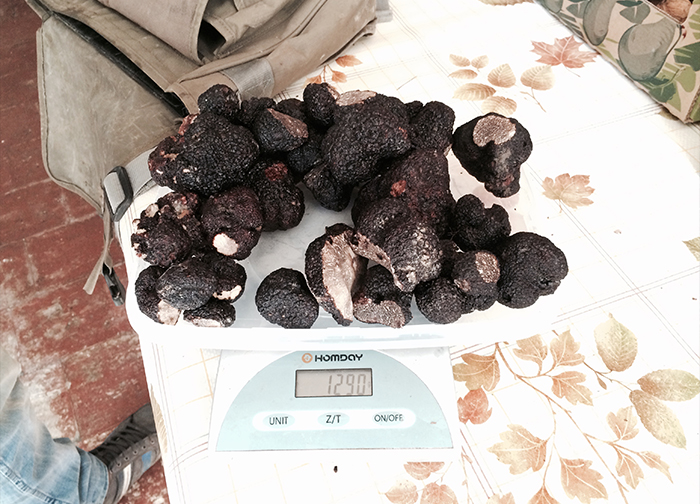Truffles
Chateau Pas de Loup has a 4 hectare black truffle forest, also known as the black Périgord truffle (Tuber melanosporum), the second-most commercially valuable species, is named after the Périgord region in France.
A truffle is the fruiting body of a subterranean fungus, the mycelia of truffles form symbiotic, mycorrhizal relationships with the roots of a host tree species, at Pas de Loup these are hazel and green oak. Mutualistic ectomycorrhizal fungi such as truffles provide valuable nutrients to plants in exchange for carbohydrates. Ectomycorrhizal fungi lack the ability to survive in the soil without their plant hosts. In fact, many of these fungi have lost the enzymes necessary for obtaining carbon through other means. Plant hosts can also be dependent on their associated truffle fungi. Geopora, Peziza, and Tuber spp. are vital in the establishment of oak communities.
In exchange for carbohydrates, truffle fungi provide their host plants with valuable micro- and macronutrients. Plant macronutrients include potassium, phosphorus, nitrogen, and sulfur, whereas micronutrients include iron, copper, zinc, and chloride. In truffle fungi, as in all ectomycorrhizae, the majority of nutrient exchange occurs in the Hartig net, the intercellular hyphal network between plant root cells.
The first mention of truffles appears in the inscriptions of the neo-Sumerians regarding their Amorite enemy's eating habits (Third Dynasty of Ur, 20th century BC) and later in writings of Theophrastus in the fourth century BC. In classical times, their origins were a mystery that challenged many; Plutarch and others thought them to be the result of lightning, warmth, and water in the soil, while Juvenal thought thunder and rain to be instrumental in their origin. During the Renaissance, truffles regained popularity in Europe and were honoured at the court of King Francis I of France. However, Western (and in particular French) cuisine did not abandon "heavy" oriental spices, and rediscover the natural flavour of foodstuffs until the 17th century. Truffles were very popular in Parisian markets in the 1780s. They were imported seasonally from truffle grounds, where peasants had long enjoyed their secret.
Truffles are notoriously difficult to cultivate. By 1808, attempts to cultivate truffles, known in French as trufficulture, were becoming successful. People had long observed that truffles were growing among the roots of certain trees, and in 1808, Joseph Talon, from Apt (département of Vaucluse) in southern France, had the idea of transplanting some seedlings that he had collected at the foot of oak trees known to host truffles in their root system. A critical phase of the cultivation is the quality control of the mycorrhizal plants. Between 7 and 10 years are needed for the truffles to develop their mycorrhizal network, and only after that the host-plants come into production.
As the volatile aromas dissipate quicker when heated, truffles are generally served raw and shaved over warm, simple foods where their flavour will be highlighted, such as buttered pasta or eggs. Thin truffle slices may be inserted into meats, under the skins of roasted fowl, in foie gras preparations, in pâtés, or in stuffings. Some specialty cheeses contain truffles, as well. Truffles are also used for producing truffle salt and truffle honey.




 © . All rights reserved |
© . All rights reserved |